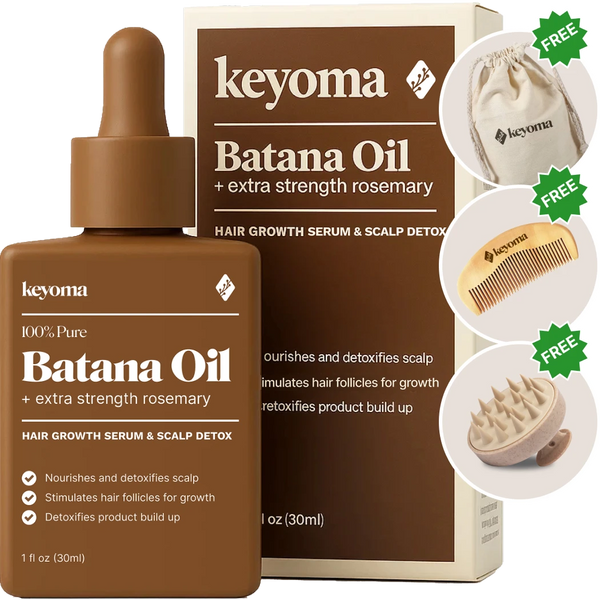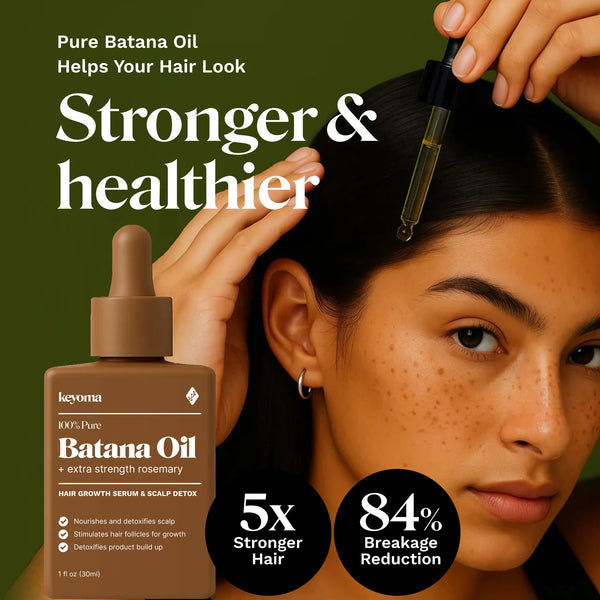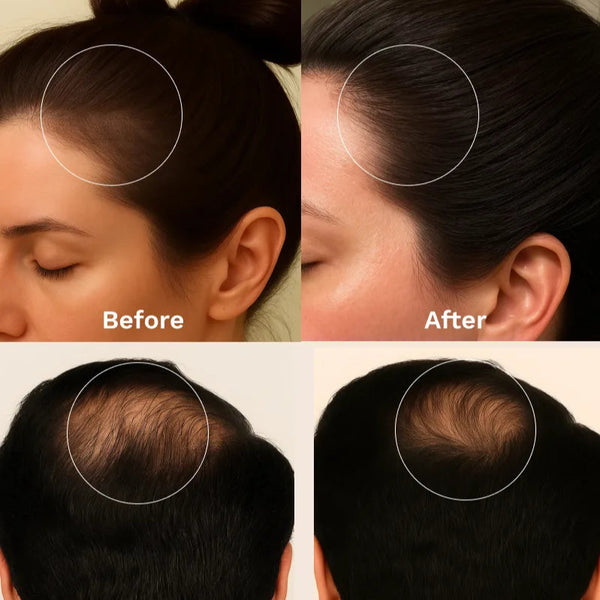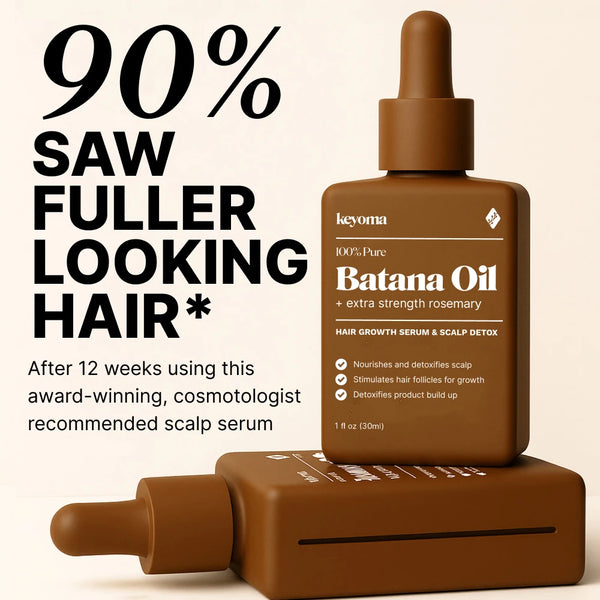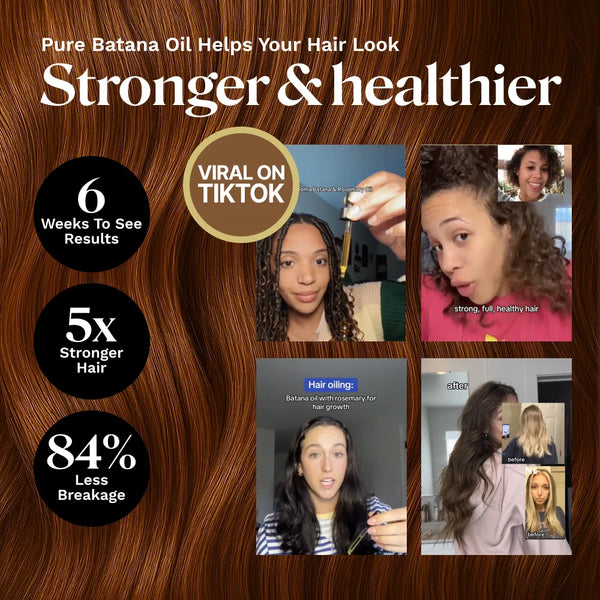In this article
Hair loss, or alopecia, can begin at nearly any stage of adulthood.
While thinning hair often appears during middle age or later, everyone’s timeline looks different. Some of us see early signs in our late teens or twenties. Others keep a full head of hair well into their 60s or older with little to no shedding.
Certain forms of hair loss reverse on their own, while others don’t grow back.
Below, you’ll learn how to spot the early signs of balding, tell natural changes from hair loss caused by other triggers, and explore treatment options when hair thinning connects to a medical issue.
What Early Balding Looks Like
Balding looks different for each of us. Some people first spot thinning near the temples. Others see their hairline begin to shift or recede.
That means not everyone notices the same signs when hair starts to shed.

You might see one or more of these common early signs of balding:
1. Hair Thinning at the Temples
Hair often begins to thin near your temples. You might also see reduced density at the crown or the back of your scalp.
2. Receding Hairline
A “receding hairline” happens when the hair at the front and sides of your head starts thinning and pulls back from your forehead. Many people notice their hairline forming an “M” shape as the sides thin out faster than the center.
This pattern shows up often in men.
3. Thinning at the Crown or Top
Thinning at the crown can sometimes signal the start of hair loss. In this case, the sides stay full while the top of your head gradually loses density.
This type of shedding often develops over time. It might take years before thinning turns into a bald spot. According to a 2012 study, this pattern appears more often in some racial groups. For example, Asian men commonly face this type over a receding hairline.
4. Part Line Looks Wider
Another form of hair thinning causes your part to grow wider, as the hair along that line starts to thin and separate.
5. Scalp Looks More Visible
A receding hairline is a well-known sign of hair loss, but other patterns like diffuse thinning—where shedding happens across the whole scalp—can lead to baldness beginning at the crown instead of the front.
Like with a receding hairline, the best way to detect diffuse thinning is to notice how your hair feels. Does it seem finer when you run your fingers through it, after a shower, or while combing?
If your hair feels less dense or looks thinner, male pattern baldness could be the cause.
6. Hair Feels Thin All Over
Some people notice uniform hair thinning across their whole scalp. The strands lose density without forming clear patterns or shapes. While men often see their hairline recede, women tend to experience gradual thinning throughout the head.
7. Hair Won’t Style the Same
As your hair begins to thin, styling often becomes harder. This can feel frustrating, especially if you express yourself through your hairstyle. Losing shape, volume, or hold in your usual styles might be one of the first signs of male pattern baldness.
If your hair no longer has its usual fullness or you find it tough to maintain familiar looks, it's smart to start monitoring your hair health. Struggles with volume or styling can signal early-stage hair thinning.
8. Hair Falls Out in Clumps
Hair loss usually happens gradually. But sometimes, you might see sudden and severe shedding. Instead of slowly thinning, your hair may come out in large bunches.
When hair falls out in clumps, it could signal a health problem. You should talk to a healthcare provider to uncover the cause.
9. Body Hair Thins Too
Hair loss doesn’t only affect your scalp. Sometimes, it also shows up on other areas where hair usually grows.
You might see less regrowth after shaving your arms, legs, or other body parts. While this can come with age, it might also point to an underlying medical issue. If you spot body hair thinning or disappearing, talk to your doctor.
How to Slow Balding With Natural and Clinical Options
When you spot early signs of hair loss, you give yourself a better chance to restart growth. Here are a few reliable treatments that target balding.
|
Hair Care Habit or Treatment |
How It Stop Balding and Supports Hair |
|
Scalp Massage |
Use your fingertips to gently massage your scalp each day. This boosts blood flow and delivers nutrients to your follicles, helping trigger new growth. |
|
Stress Control |
You cannot always eliminate stress, but you can manage it. Tools like deep breathing, exercise, or therapy can support your mental health and give your hair a break. |
|
Balanced Meals |
Include iron, protein, and vitamins A, D, E, and B in your diet. These nutrients fuel hair strength and support steady growth. |
|
Add More Protein |
Your hair depends on protein. Without enough, your strands turn dry and weak. Boost your intake with eggs, fish, tofu, or legumes. |
|
Take Vitamins |
Ask your doctor to check for deficiencies. Low levels of vitamins A, B, C, D, and E are linked to thinning. Supplements may help fill the gap. |
|
Essential Oils |
Apply oils like batana or rosemary to your scalp. These oils may help activate growth and nourish your roots. |
|
Skip Hot Tools |
Daily heat from curling irons or blow dryers can dry out strands and damage follicles. Let your hair air dry or use low heat when needed. |
|
Loosen Tight Styles |
Styles like braids or ponytails can tug at your roots and weaken the connection to your scalp. Opt for looser looks when possible. |
|
Use A Mild Shampoo |
You do not need to wash less often—but wash smarter. Choose a shampoo free from sulfates and strong chemicals, and handle your hair gently in the shower. |
|
Keep Hair Clean Overnight |
Clean hair helps prevent scalp buildup and skin issues that can disrupt growth. Sleep with a silk pillowcase or loose braid to reduce friction. |
|
Scalp Hygiene |
Wash your scalp with a mild formula that fits your hair type. Clean skin supports strong follicles. Stay away from harsh cleansers. |
|
Change Up Your Style |
Try new hairstyles that reduce tension on your roots. A simple switch can lower breakage and help hair stay stronger. |
|
Handle Hair With Care |
Use a wide-tooth comb to detangle gently. Avoid yanking or pulling, which causes unnecessary stress and snapping. |
|
Quit Smoking |
Smoking limits blood flow, which can hurt follicles and slow growth. Stopping can protect your strands and support scalp health. |
|
Medication Options |
In some cases, prescription drugs—oral or injectable—can help lower inflammation or hormone levels that trigger hair loss. Talk to a healthcare provider about what is right for you. |
Take Control of Balding Naturally With Keyoma
Knowing the triggers and signs of crown balding helps you catch it early and respond with the right care. From topical solutions and oral medications to transplants and non-surgical therapies, you have options to slow or reverse hair loss.
Support your scalp daily by improving your routine—choose nutrient-rich meals, manage stress, and treat your hair gently.
Start with Keyoma Batana Oil—a natural treatment that nourishes the scalp and supports fuller, stronger growth. Make the shift now and reclaim healthier hair with consistency and care.
Featured Product
100% Pure Batana Oil + Rosemary
↓Best Batana Oil to Buy↓
1 Month
Subscribe & Save
- 30-day supply delivered monthly $35
- 30% off for life $6
- Free haircare essentials kit $33
- Free custom wooden comb $10
- Free scalp massager $15
- Free eco-friendly travel bag $8
- 30-Day Money Back Guarantee
- Free Shipping
- Online portal for easy cancel, skip, or pause.
1 Month One Time Purchase
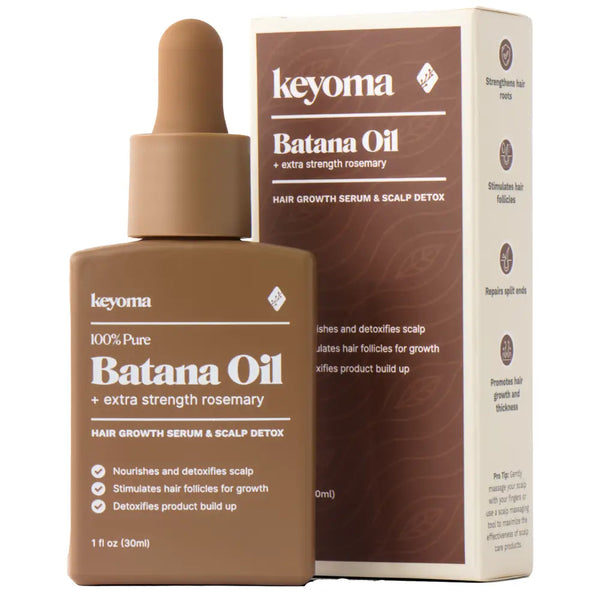
- 30-day supply $50
- 30% off for life $6
- Free haircare essentials kit $33
- Free custom wooden comb $10
- Free scalp massager $15
- Free eco-friendly travel bag $8



